Plan Your Visit
Ticketing and Seating 101
With dozens of performances to choose from in DPAA’s season and several gorgeous venues, choosing the right seat can be overwhelming—which seat is perfect for me? Here are a few tips to consider when picking out your seat.
Does DPAA have discounted tickets?
DPAA offers a variety of programs and tickets at discounted rates for students, seniors, military, and more.
Through a unique partnership with AES Ohio, the DPAA offers $5 tickets to most all of its performances. Tickets become available at the beginning of each month on a first-come, first-served basis, and may be purchased online or at the box office.
DPAA has also partnered with Dayton Metro Library to allow all cardholders to “check out the arts” free of charge! Tickets can be checked out by visiting or calling the box office. Tickets are limited per show, and availability is on a first-come, first-served basis. Participants must show their Dayton Metro Library card to collect their ticket.
DPAA offers a Military Appreciation Program for active-duty military members, retired veterans with ID cards, and WPAFB government civilian employees in the Miami Valley area. Patrons receive one pair of free tickets per military household to use between September and December 2023, and one pair of free tickets per military household to use between January and June 2024. Military members also receive $5 off any additional ticket purchases.
Students receive 50% off adult prices, making many of these tickets available for less than $20. Students must show a valid student ID.
Please note that promo codes cannot be applied to ticket programs and these offers cannot be combined with each other.
Do you want to bring your organization or school to a performance? Group sales are available for groups of ten individuals or more, and discounts start at 10% off adult-priced tickets. To learn more about special rates or to book your group, call the DPAA Marketing Department at (937)-224-3521.
What are the sections of the theatre called?
The Schuster Center has four levels: orchestra, loge, lower balcony, and upper balcony (and in the Victoria Theatre, it’s just orchestra, loge, and balcony).
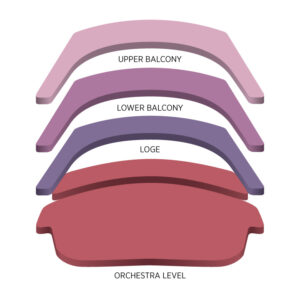
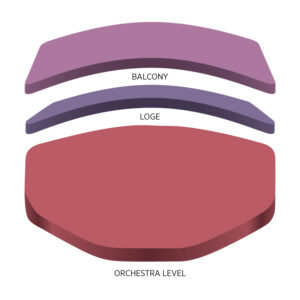
The balconies offer the most panoramic views of the theatre, but they are probably not the best place for anyone afraid of heights. The loge (pronounced lohzh) is the lowest balcony.
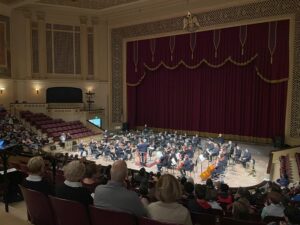
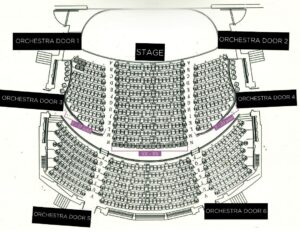
The orchestra level is the main level of the theatre and offers the closest seating to the stage. The Greek etymology of the word “orchestra” refers to the position in the theatre where the musicians play, not the ensemble itself. And in Greek theater, the orchestra would play on the floor with seats tiered around them, which is why we call the bottom level the “orchestra level.”
At the Schuster Center, the orchestra level is divided into three sections by the aisles. Seats on the side sections are numbered odd (on the left) or even (on the right), and the seats in the middle section use a 3-digit number starting at 101. So, if you’re in seat J2, your friend is in J4, and you’re worried about the stranger sandwiched in between, fear not! You and your friend are right next to each other on the left side of the theatre.
Then there are the Box seats. Boxes are located on each level of the Schuster and can accommodate patrons with accessibility needs or patrons who want a bit of extra space. Click here to learn more about our accessibility accommodations.
Which seat in the house has the best sights and sounds?
When attending a concert with Dayton Philharmonic, sound is probably the most important factor in choosing your seats. The farther you sit from the stage, the more blended the orchestra will sound. When you sit close to the stage, you’re more likely to hear the strings and the guest soloist because they’re in front. If you frequently attend our concerts, this is your chance to experiment with sound and choose different places throughout the house to determine what sounds best to you.
For Dayton Opera and Dayton Ballet productions, the view is the most important factor.
First, let’s talk about the coveted front-row seats. Are they as good as they sound? It depends on what you’re looking for in your experience! Sometimes, you’ll be craning your neck or looking at the performers’ feet, but it’s not all bad. For operas and orchestra concerts, you’ll have the best view of the performers’ facial expressions. At ballets, you’ll have a razor-sharp eye on the dancers’ footwork. And when the Philharmonic performs in the pit during a ballet or opera, you’ll have the best view of all the performers at work.
The box seats are also coveted but have their pros and cons. True, the boxes above the stage can make it feel like you’re right in the middle of the performance. However, it doesn’t provide the best sound, and the staging is typically designed for someone to see straight-on.
There are plenty of easter eggs to look for depending on where you sit. For example, the front row of the loge is the best place to watch ballet because you can see the formations they make on the stage; the last row of the upper balcony allows you to take in the performers and audience; and the center of the rear orchestra perfectly frames the stage in your sights. This is all to say, the perfect seat is unique to you and what you want to see. Next time you’re at the hall, take a few minutes before the concert to walk to all the different sections. See which views you find more interesting than others.
For Artistic Director and Conductor of Dayton Philharmonic, Neal Gittleman, he says, “When I listen to the orchestra in the hall, I like to sit in the elevated area of the Orchestra—around Row P. For opera, musicals, or dance in the Mead Theatre, I always try to sit right in the middle of Row N. That’s where the production team sits during rehearsals, so I figure if I sit there, I’m seeing what they want me to see!”
Where should I sit for the most relaxing experience?
For some, their concert experience is better when they’re elbow-to-elbow with the patrons around them, experiencing the performance together and striking up conversation during intermission. For others, sitting in less dense sections provides more room to relax. Whichever you prefer, here’s what you’re going to do: The densest sections of the theatre are the middle section of the orchestra level and the first few rows of the loge and balconies. If you’re more comfortable sitting away from the crowd, try the outer edges of each level, the upper balcony, or a box.
Fortunately, the ticket agents at our Box Office are experts in our venues. If you explain to them the experience you’re looking for, they can find your perfect seat. Visit them at One West Second Street or call (937) 228-3630 from Tues-Fri 10AM – 6PM.
Performance Day FAQs
What is the dress code?
There is none! An outing at DPAA can be as casual or as dressy as you’d like. You’ll see everything from denim to sequins!
Most importantly, you should dress in whatever makes you feel most comfortable. And if you’re looking for an excuse to dress up, the opera, ballet, or symphony provides the perfect opportunity!
Where are Dayton Performing Arts Alliance performances?
DPAA performances take place at the Benjamin and Marian Schuster Performing Arts Center and the Victoria Theatre. These venues are both owned and operated by Dayton Live.
On occasion, DPAA performs at the Dayton Masonic Temple, the Dayton Art Institute, and the Loft Theatre.
I’m not familiar with the Downtown Dayton area. What is there to do before or after the show?
Downtown Dayton is full of great amenities, dining options, fun experiences, and more. Visit the Downtown Dayton Partnership’s website for a full list of events, restaurants, and recreational opportunities in the area. And if you’re a subscriber, check out this list of VIP dining partners where you can get a discount on your meal on the day of a performance.
Where should I park?
The Arts Garage, located on the northwest corner of Second and Ludlow Streets, is secure, clean, and staffed by on-site attendants. With four floors of parking available, it’s a great option for parking for events at the Schuster Center and Victoria Theatre. Street parking is also free on the weekends.
Dayton RTA offers safe and on-time public transportation to downtown Dayton. Visit their website to view routes and schedules.
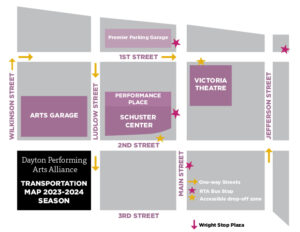
When do your performances start?
Performances on Fridays and Saturdays begin at 7:30 pm and Sunday matinees begin at 2:30 pm. This is subject to change, so make sure to check the event page and our Know Before You Go email for your performance time.
When do doors open before a performance?
The theatre lobbies open one hour before performances. The seating area opens 30 minutes before the performance.
What do I do when I get there?
If you haven’t attended a performance with us before—or it’s been a long time—it’s understandable that you’re not familiar with our facilities. Let’s break down, step-by-step, what to do when you arrive at the theatre.
Enter through security. Before entering the venue, you will pass through an electronic security system. It does not interfere with medical devices. However, you may request alternative screening measures.
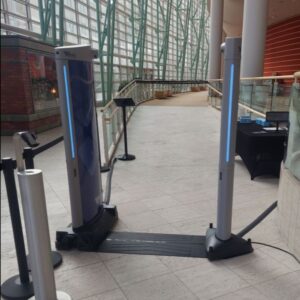
Pick up your ticket from Will Call. If you choose to pick up your tickets rather than printing them at home, then you need to stop at Will Call to get your tickets. In the Schuster Center, Will Call is located near the Main Street entrance, next to the Starbucks. In the Victoria Theatre, the box office is located to the right, immediately through the first set of doors. It’s best if you have your ticket confirmation email on your phone at this time, so agents can find your tickets quickly.
Enter the ticketed area. The ticketed area opens one hour before the performance begins. At the Schuster Center, you will see volunteers at the Ludlow Street entrance and in the Wintergarden that will scan your ticket. Remember to keep your ticket with you if you need to leave the ticketed area, as it will need to be scanned again for you to enter.
Visit the concessions. At most performances, we provide a full bar including beer, wine, liquor, soft drinks, and water—plus Starbucks in the Schuster Center Wintergarden. Beverages are permitted in the theatre, but we require that you finish your snacks and food in the lobbies as crunchy foods and crinkly packaging can be a distraction to other patrons.
Hit the restrooms. This one may seem obvious, but you never know when nature calls! However, should you need to exit the theatre for any reason, there is a possibility you may not be readmitted until the next opportunity for seating. It’s usually about 45 minutes until intermission.
Check out the pre-show events. At select performances, DPAA provides pre-show events, such as a dance floor, performances by our Learning Programs or community partners, and activities for children. At Masterworks and Opera performances, the artistic directors host a “Take Note” program where you can learn more about the composer(s) and piece(s) featured at that performance. Be sure to check your Know Before You Go email for pre-performance events.
Visit the welcome table. Located near the grand staircase, DPAA’s marketing team staffs a customer service station where you can ask questions about your tickets, inquire about the season, or just say hi!
Take a selfie. Find the DPAA backdrop, grab a friend, and snap a picture so you never forget your experience at the ballet, opera, or symphony. Of course, don’t forget to post it and tag us on Facebook and Instagram: @daytonperformingartsalliance.
Just people-watch. You’ve survived the hustle and bustle of making it to the theatre, so now it’s time to relax! Take a seat on one of the benches located in the lobby, take in the sights, and get to know your fellow concertgoers (or don’t—quiet time is wonderful too).
Take your seat. The theatre area opens 30 minutes before the performance begins, at which point you can go take your seat. But if you’d rather look around a little bit longer, the House Manager will make several calls over the intercom to let you know when it’s time to go inside.
